Eight Lessons from My Panettone Saga
A Wordloaf guest post from Olga Koutseridi
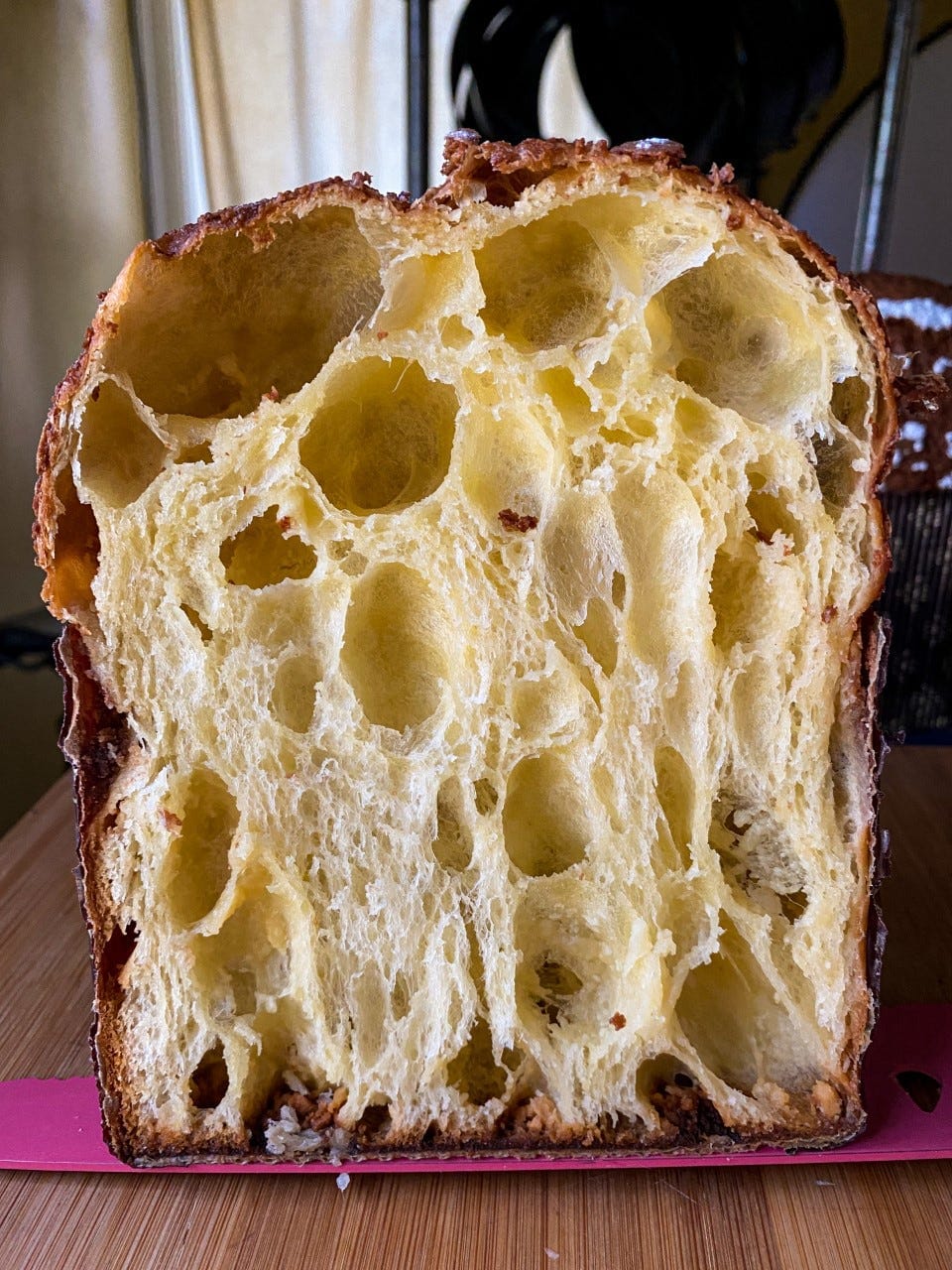
Table of Contents
Panettone, Italian sweet bread traditionally prepared and served at Christmastime, has a reputation for being one of the most challenging breads to pull off successfully. The best versions have a supremely soft texture, an improbably open, vaulted crumb structure, and a weeks- or even months-long shelf life. While you can make decent facsimiles using commercial yeast, the hallmark characteristics of a classic panettone are only possible when it is made using sourdough, and that’s where the problems lie. While no sourdough baking processes can be considered “simple”, panettone is definitely takes complications to the extreme, with an unusual levain maintenance method (“pasta madre”, or mother dough), two dough builds (the “primo” and “secondo impastos”), and the necessity for exacting temperature and pH control throughout the process. It’s a bread that I’ve put off trying to make myself because I knew that the learning curve was windy and precipitous.
Still, I knew I wanted to tackle it someday, which is why I reached out to Olga Koutseridi, a baker whose amazing breads I’ve been admiring for ages now on Instagram, where she goes by @olia_cooks, for advice. She taught herself to bake panettone over the last few years, and kindly offered to write up a detailed set of recommendations for beginners, just the sort of tips she wished she’d been given when she began the journey.
This post has been in the works for a long time now, I and I am excited to share it with you all, hopefully in time to help if you’d planned to make panettone this upcoming holiday season. Thank you, Olga!
—Andrew
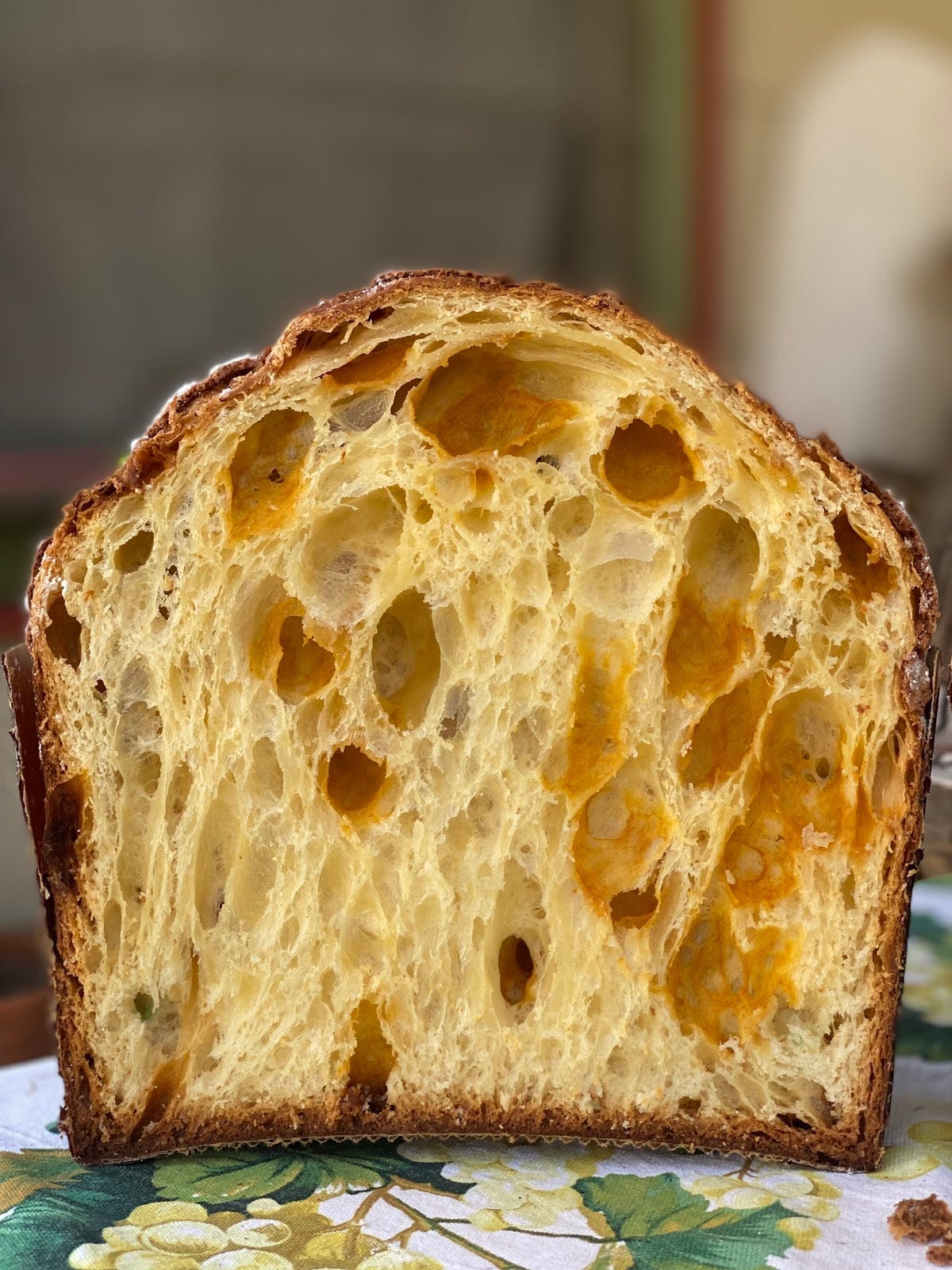
8 Lessons from My Panettone Saga
words and photos by Olga Koutseridi
I love enriched doughs—the more butter and egg yolks the better. You can see some of my creations on my Instagram page, where I have been documenting my panettone journey all along. I began baking sourdough in 2016, and as many sourdough baked goods as I possibly could from around the world. I was obsessed with perfecting my naturally leaved croissants, ensaïmada, babka, baba au rhum, brioche, kardemummabullar, bagels, simit, pizza and of course endless loaves of bread.
Four years into my sourdough baking journey, in 2020, I finally felt ready to accept the challenge of panettone, the Mount Everest of enriched doughs. When I did so, this bread became the sole focus of my baking attention. In the beginning, I was focused on research—I read everything and anything I could find on the topic, I translated books from Italian, and I interviewed panettone bakers. After months of being stuck in research mode, I finally began experimenting, and I spent almost every weekend practicing. As of today, I am two and a half years into my journey; I have learned so much along the way, and want to share some of my insights with anyone else who decides to embark on their own panettone baking journey.
First things first, you will make a lot of mistakes; many things will go wrong, honestly maybe even most things. When I began making panettone, I knew it was going to be hard, but no one ever told me outright just how hard it would be. Looking back, I wish someone had told me just how much I should expect to mess up, how much can and will go wrong. If you are planning on baking panettone this holiday season, you’ll want to start practicing as soon as possible. (And to give yourself some peace of mind, maybe go ahead and pre-order a backup loaf from one of these amazing panettone producers.)
Panettone taught me how to fail (A LOT), helping me build up my resilience muscles as a baker and human, and I’m sure it will do the same for you.
Overview of the panettone process
The whole process of making panettone from start to finish on average takes 3 days. You always begin with an active lievito madre, a stiff sourdough starter at between 40% and 45% hydration, one that triples in volume in 3 to 4 hours at 82˚F (28˚C) to 86˚F (30˚C). Once you have a healthy and strong lievito madre, you are ready to move onto the next stage, the primo impasto.
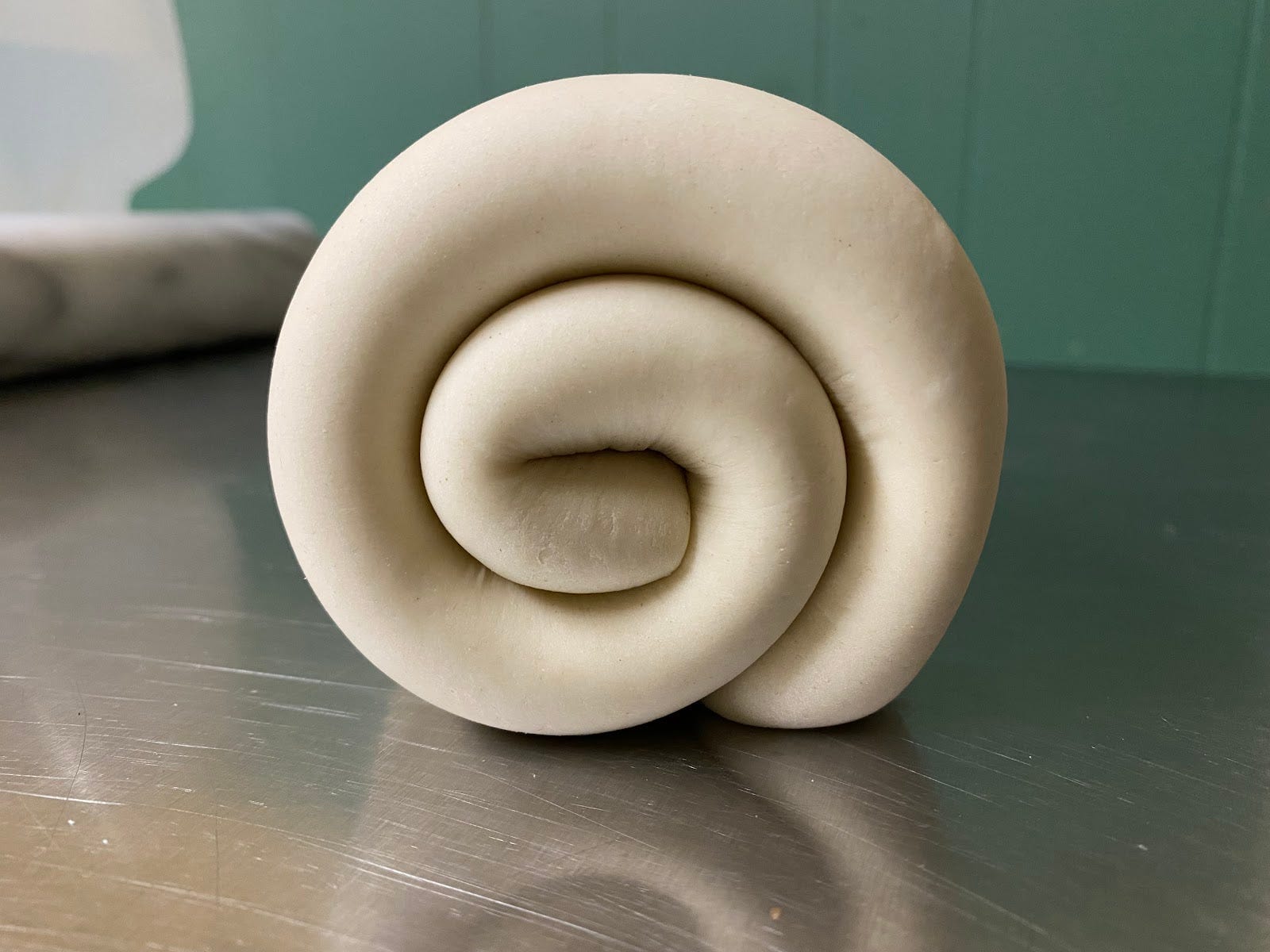
Panettone is a two-dough build. You start by mixing the first dough, or primo impasto, which takes anywhere between 25 to 45 minutes. Then you let the first dough ferment anywhere from 8 to 20 hours between 68˚F (20˚C) and 79˚F (26˚C) depending on the formula. Knowing when to end the fermentation of the first dough is absolutely vital to your success! (More on this later.)
Once the first dough is ready, you are ready to mix the second and final dough, or secondo impasto. The second dough takes between 45 to 60 minutes to mix. After that, you divide, preshape, and bench rest the dough anywhere from 20 minutes to an hour. Next, you complete a gentle final shape and place the dough inside panettone molds. Then you let the dough proof between 3 to 8 hours (or longer) depending on the formula, at temperatures between 79˚F (28˚C) and 88˚F (31˚C). You will know the dough is finished proofing when the edge of the dough is around 2 cm below the mold.
At this point, you score or glaze the top of the panettone and bake it between 320˚F (160˚C) to 350˚F (175˚C), until the internal temperature is 199˚F (93˚C). Finally, you carefully but swiftly remove the panettone from the oven, insert skewers (such as these) at the base of the mold (if you didn’t insert them before proofing), flip, and hang the loaf upside down to cool for no fewer than 11 hours before cutting it open.
Cooling the panettone upside down prevents it from collapsing before it is fully set. You’ll need to set up a hanging apparatus or create a hanging area to do this. I usually hang mine between two large flour bins, but others use a clothing drying rack or suspend the loaf over a bowl. (Some bakeries use specially-designed upside-down cooling racks for cooling panettone like these.)
There are a lot of stages to the panettone process, which is the main reason it is such a challenging bread to pull off. Ultimately, your main goal as a panettone baker is to make sure that each one of these stages are carried out just so.
Lesson 1: Focus on the process
Baking panettone is a lesson in paying attention. You need to closely observe every single step of this incredibly long process. Maintaining your lievito madre and baking panettone is a highly individualized set of techniques; each baker has their own way of doing things. Therefore reading books and blog posts has its limitations. It will of course provide you with a strong foundation and theoretical understanding. On the other hand, little to none of this will apply to your exact environment, ingredients, tools, and overall conditions. Therefore, the only real way to learn how to bake panettone is by baking frequently and by being fully present when you do. Constantly ask yourself questions such as, What does my healthy lievito madre look, smell , and feel like? How does it behave? Does it smell fruity, yogurt-like or acetic (vinegary) What does my first dough look, smell, and feel like after the first 8 hours of fermentation, 12 hours, 15 hours, etc.?
Develop a habit of asking yourself a lot of questions. My advice is to keep a panettone journal and record notes from your baking experiments. This way you can write down your observations, take photos, and—as I strongly recommend—take videos of the doughs at different stages as well. If you do not pay close attention it will be incredibly difficult to actually learn and improve. Personally, I kept ignoring this piece of advice and subsequently paid for it in time, money, and a lot of energy. It finally hit me when a baker I deeply respect told me to stop reading and start experimenting and practicing. When my focus shifted away from absorbing information I was accumulating through research to my own experimentation, I began to really understand how to read my lievito madre, my first dough, and my second dough through the entire process. This was a paradigm shift in my panettone baking.
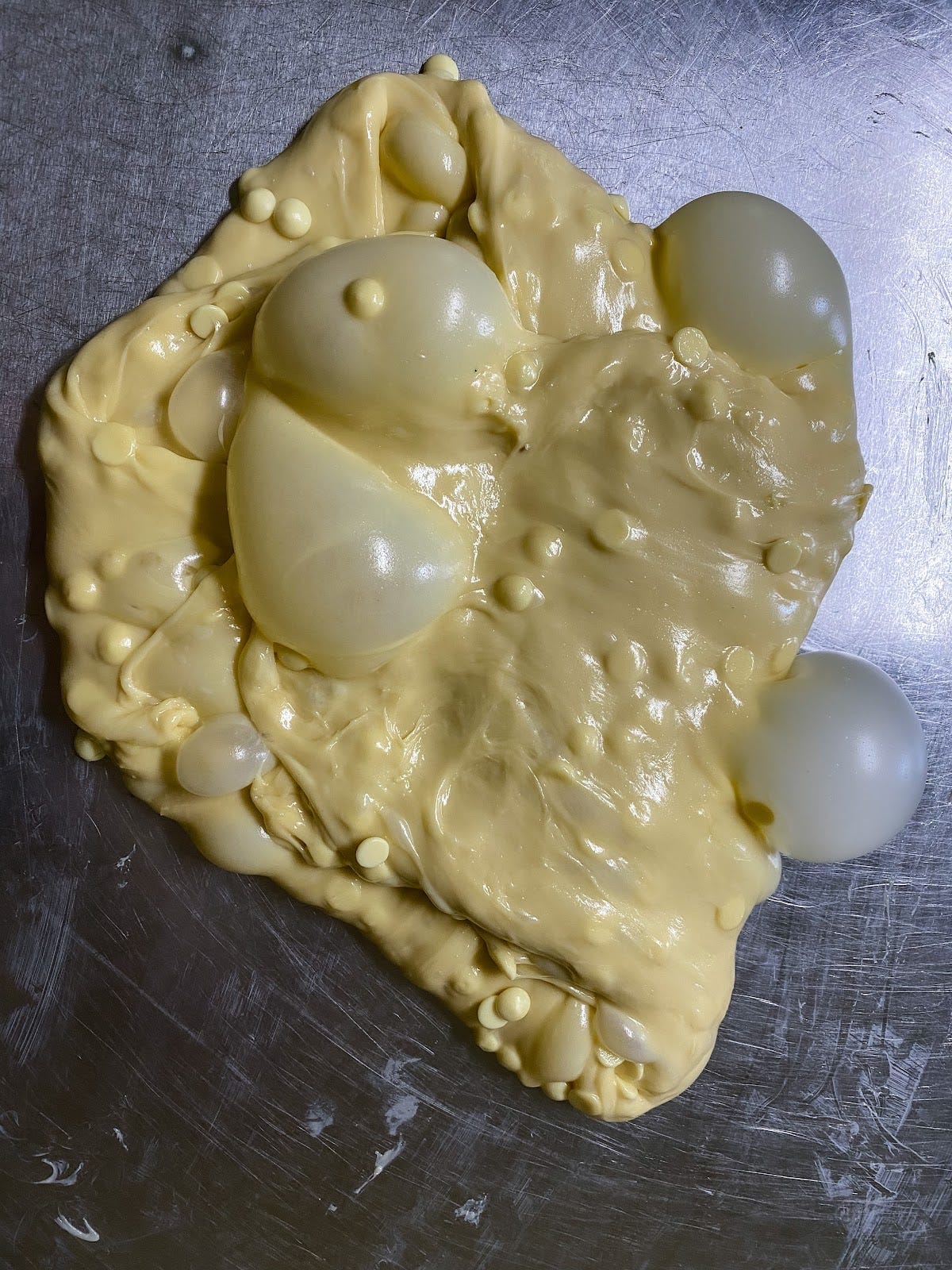
Lesson 2: Set smart goals
This is very important! Don’t let the expectations you have for the final product you are striving to produce be the central and sole motivator for each bake. Letting go of this mindset will save you a lot of heartache. Set goals that focus on what you want to learn from each bake rather than the type of product you want to make.
Yes, it is helpful to have a list of criteria that you want to achieve in your ideal panettone. On the other hand, especially in the beginning of your journey, the focus of each bake should be on something you want to learn. For example, instead of saying, “I want to bake an open crumb panettone,” instead try: “For this batch of panettone I want to experiment with one new ingredient, flour. I want to observe how this flour behaves during mixing and after the first 8 hours of fermentation at 77 F (25 C).” It is not helpful to judge your panettone baking based on whether you have achieved your ideal “final product.” Focus instead on setting process-based or learning-focused goals and the final product goals will organically follow. In other words, trust the process.
Lesson 3: Start with the Right Formula
When you are just starting to bake panettone it is critical to start with a formula that is well-balanced and user-friendly. God, how I wish someone would have said that to me when I was starting! I would have been even happier if someone would have actually shared a well-balanced formula with me, which I’ll do for you right now: I’m happy to share my favorite formula with you. The best formula to start baking panettone with is Piergiorgio Giorilli’s. I have tried a lot of formulas over the years including those by Morandin, Yann Duytsche, Alberto, Massari, Alfonso Pepe, Roy, Ezio Marinato, and the École internationale de boulangerie, and of all of them, this one is the tops.
The reason I think Giorilli’s formula is good for beginners is because it has an especially well-balanced first dough with a proportional amount of yolks, sugar, butter, and water, the four things that impact the speed and quality of fermentation. Additionally, Giorilli’s formula works well with King Arthur bread flour, a flour that is easily accessible to most U.S. home bakers. Finally, it produces some of the best-tasting panettone I have ever baked, with a super-tender and beautifully-aerated crumb.
You can find Giorilli’s formula here, as adapted by Michael Wilson on his Italian Baking blog l’arte bianca and his blog post on thefreshloaf.com.
Also: Be sure to practice with only one formula! Bake it over and over and over again until you understand how each step of the process works, and if you make changes to it, only alter one variable at a time with each bake.
Lesson 4: Temperature is key
One of the biggest insights I want to share with you all about baking panettone is how incredibly important temperature, or to be exact temperature control, is. It is key to your panettone success. This includes both the lievito madre maintenance (bound/legato or in water/in aqua), and the two dough stages. Having a strong sourdough baking background, I knew the importance of temperature for baking sourdough, but panettone takes it to a whole new level. And if there is one place I think investing money in tools for panettone making is useful, it is in the area of temperature control.
Let’s start by looking at lievito madre maintenance. Breaking news: The health of your lievito madre depends almost exclusively on temperature control! It is not the flour or a specific maintenance process, it’s temperature. You need to be able to provide a controlled environment for your lievito madre for overnight maintenance. The temperature has to stay between 60 F (16 C) and 66 F (19 C) for up to 24 hours. In order to do this, especially in Texas, I had to purchase a small wine cooler. Once I was able to control and maintain my pasta madre at a consistent temperature, my panettone baking game improved significantly.
You also need to be able to provide a warm environment during the lievito madre refreshments, the step you take before mixing the first dough. Most bakers keep their lievito madre between 82˚F (28˚C) and 86˚F (30˚C) for 3 to 4 hours. You can purchase a proofer or incubator to do this. In my case, I converted an old cooler into a proofer using a USB-powered PC case fan, ceramic heat bulb, and INKBIRD temperature controller or thermostat.
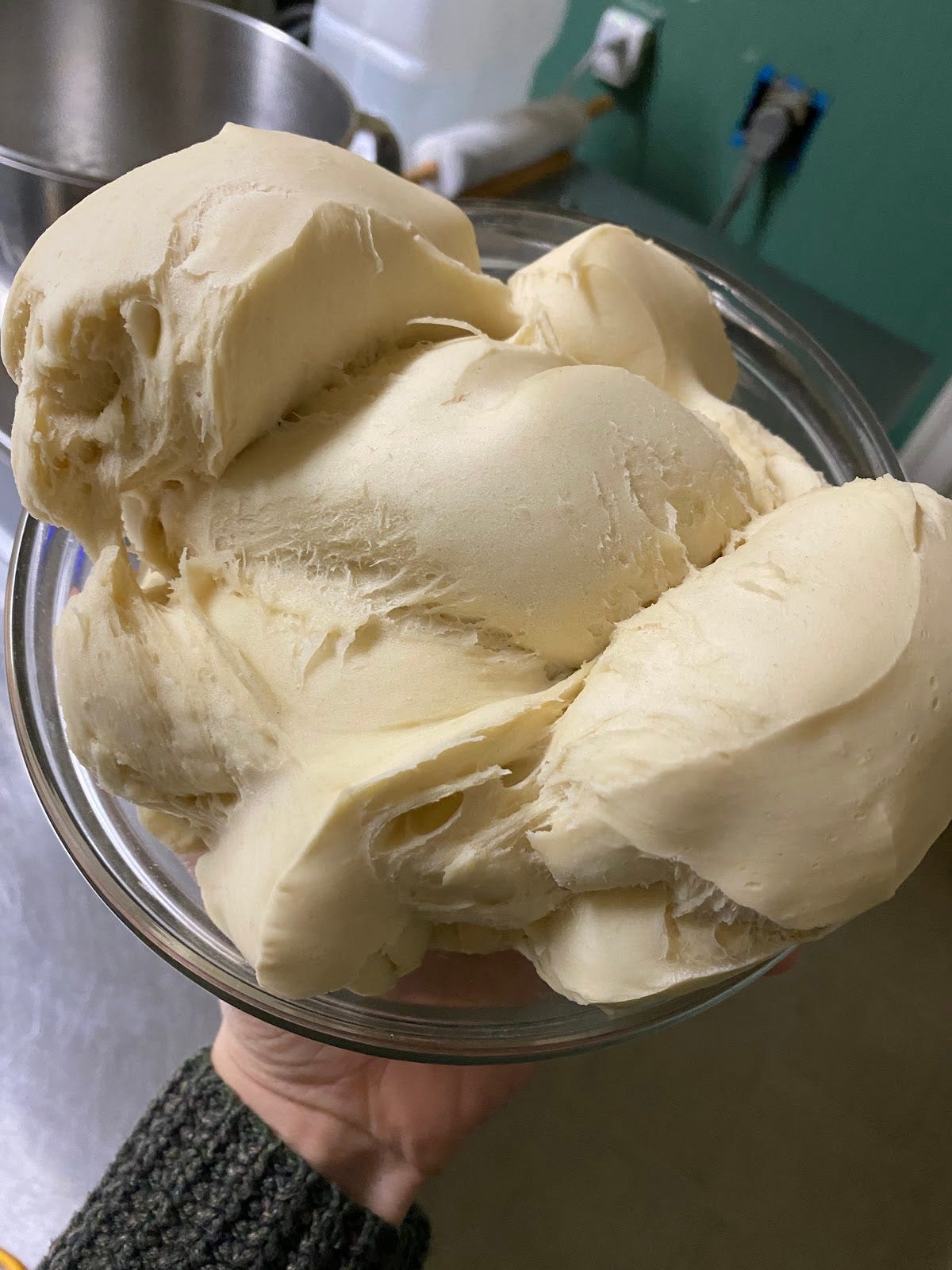
The third most important phase that requires temperature control is the fermentation of the first dough. Depending on your formula, you will need to be able to keep your first dough at a consistent temperature for 8 to 20 hours, anywhere between 68˚F (20˚C) and 79˚F (26˚C).
Temperature is as a factor during mixing too; in this case, we are talking about dough temperature. The ideal dough temperature for both doughs during mixing is 77˚F (25˚C) and ideally never greater than 82˚F (28˚C). (Unsurprisingly, mixing panettone in Texas, especially between the months of May and October, is incredibly challenging.) I rely heavily on ice packs, placing them all around the mixing bowl, which helps to control the dough temperature from rising as a result of mixing friction. (Spiral mixers are gentler than stand mixers, but both produce friction.) Another way I control temperature is by taking frequent breaks during mixing and monitoring the dough temperature throughout the process. I refrigerate all of my ingredients for several hours before mixing the two doughs, so that the dough starts off as cold as possible, and I refrigerate the first dough for at least an hour before using it to mix the second dough. Finally, I try to control the temperature of the room I mix in, using air conditioning; definitely don’t try to mix panettone in a hot kitchen with the stove or oven turned on.
Lesson 5: No, you don’t need a pH meter
I get this question all the time: Do I need to buy a pH meter if I want to bake panettone? I am here to tell you that no, you do not need to buy this expensive tool to bake or start baking panettone. If I could give my younger self some advice, I definitely wouldn’t have bought a pH meter at the beginning of my panettone baking journey. (In case you were wondering, this is the one I have.)
Unfortunately, using the pH meter did not help me improve; instead, all of my attention went towards tracking, measuring, and recording my pH readings. But a pH meter doesn’t give you a complete picture of the acidity (called Total Acidity Measurement, or TTA) in the dough. A pH meter indicates is the pH (potential of Hydrogen), but it says nothing about what kinds of acids are present. In other words, it gives you the overall acidity, but doesn’t provide you with much information on whether you have more lactic or acetic acidity. And it is this nuanced information that you actually need to make specific adjustments. Therefore you have to learn how to read your lievito madre and panettone doughs directly! At least for now, there is no tool that can do it for you. There are no shortcuts here, you have to learn how to rely on your senses.
Lesson 6: It’s all in the timing
After temperature, timing is the second most important aspect of panettone-making. I want to focus on two places where timing is most fundamental to success. The first is during mixing, especially knowing when to stop mixing the first dough. You want the first dough to be strong and well-developed, but you don’t want it to become glossy and super-extensible (stretchy), which is a sign that the gluten has been damaged and can lead to further gluten degradation during fermentation.
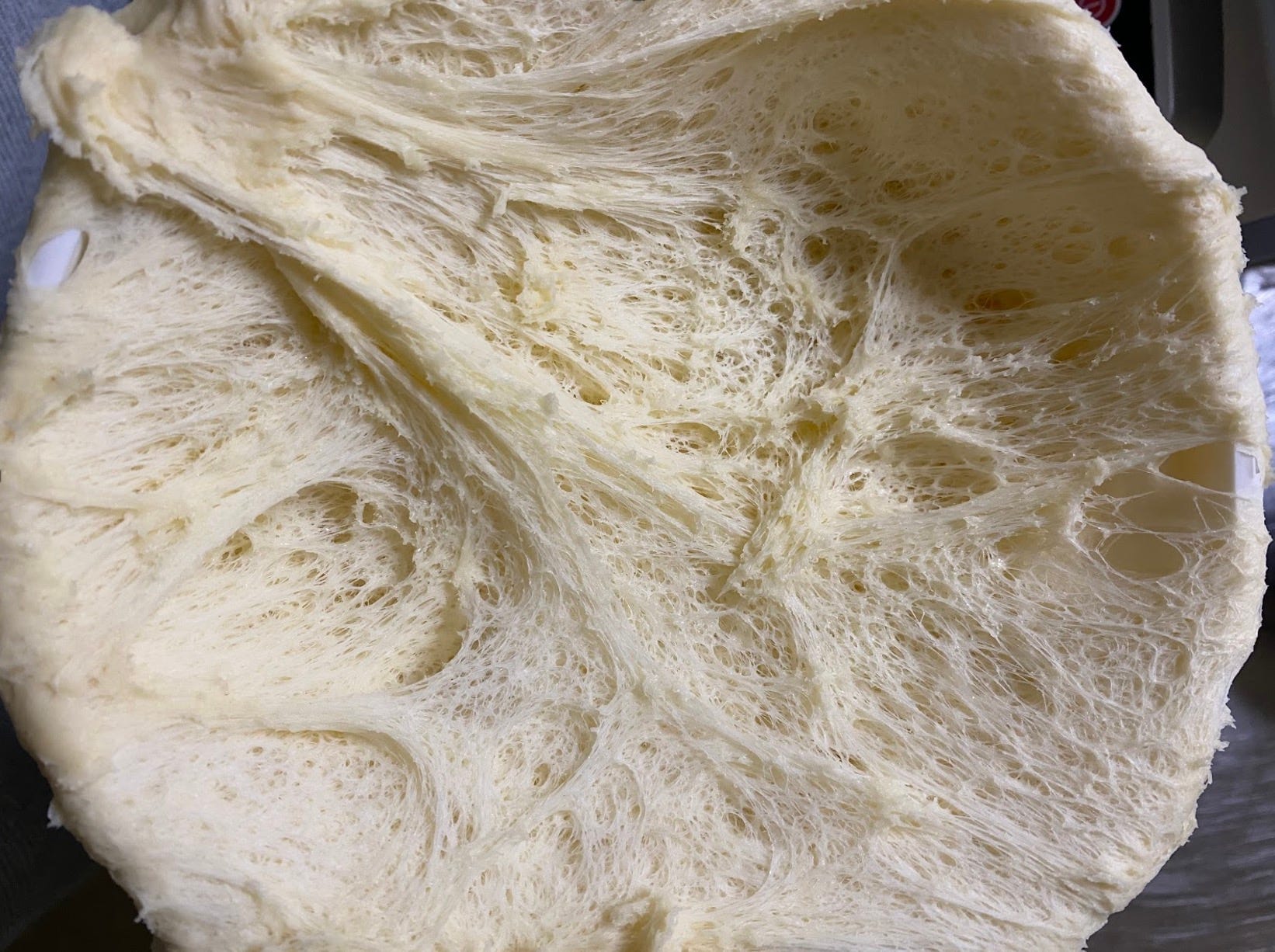
The second place that timing is important is in knowing when to stop the fermentation of your first dough. Here are some very important things I learned: If the first dough feels oily or greasy at any point during fermentation and it has a pungent acetic (vinegary) smell, this is usually indicative of it having undergone acidification. Additionally, if you tear open the first dough (as you see in the photo above) and you do not see a strong gluten network this is another sign that things have gone wrong and the gluten network has started to degrade.
In summary, the more acidity your first dough takes on, the more fragile the gluten structure becomes. And if your first dough is acidic and fragile, it will make the mixing of the second dough either incredibly hard or (more likely) impossible. If your dough is over-acidified, stop here and try again from the start. Do not attempt to mix the second dough, since it is most likely going to lead to wasted ingredients. Or if you do attempt to mix the second dough, use it as a learning opportunity to see how differently the dough behaves when it has a high level of acidity. I learned these lessons the hard way myself.
At this point you might be asking yourself, How do I know when the first dough is done? Simple: Use volume as your indicator, by placing your first dough in a container that makes it easy to easily visualize volume increase. (My favorite are the cambro containers.) Additionally, you can place a small amount of dough (~50g) into a small graduated glass beaker, and keep the first dough and graduated beaker together in the proofer.
When to end fermentation depends upon the formula you are using, but it is usually when the dough has doubled, tripled, or quadrupled.
Lesson 7: Find Community
Find your people. Don’t go through this alone. One of the best things to come out of my panettone baking journey is the community of friends I made. If I could do it again, I would focus on finding other people who are at the beginning of their panettone baking journey and create a panettone baking support group. This is a great way to brainstorm solutions, celebrate wins, troubleshoot, share experiments, and provide encouragement. This article started with an outline of how difficult baking panettone really is and the amount of emotional labor you will exert. Community is a critical aspect of how you can get through this in a sustainable and supportive manner.
Lesson 8: A few odds and ends
Don’t compare yourself to others. I know that being on social media can very easily lead to this type of comparison. Use social media to find community and inspiration, not to use other people's results to evaluate your own progress or shame yourself. I fell into this mindset myself when I first started baking panettone, which led me to make some really bad decisions, such as attempting to bake panettone using Roy’s formula way too soon in my baking journey. This formula is notoriously difficult because of its high water amount, very large quantities of butter, the use of specialized Italian flour with a very high W index of 390/420 and machinery such as a diving arm mixer. (In short, the W index is used by bakers to assess the strength of the flour). You can find Roy’s formula in the Sourdough Panettone and Viennoiserie book.
How to convert your liquid sourdough starter into lievito madre or stiff starter. It is super simple and just think of it as your new starter that you will maintain at a much lower hydration. Here is how you convert it, gradually reducing the hydration:
- Combine 100 grams of 100%-hydration starter, 100 grams of flour, and 50 grams of water and let proof for for 12 hours. Repeat this new feeding ratio 2 more times.
- Then switch to the final hydration (45%): 100 grams pasta madre, 125 grams flour, and 56 grams water (45% hydration). Continue feeding using this ratio twice a day for 5 to 7 days. At this point, you’ll have produced the correct microbiome of bacteria and yeast required for panettone baking. The best way to tell if the lievito madre is ready is by testing it with a good panettone formula.
- You can now transition into maintenance mode. You can learn about the different ways of maintating your lievito madre here.
Lastly, if you are planning on maintaining your lievito madre in the fridge at 40˚F (4˚C) and not a wine cooler, you will need to incorporate a technique called bagnetto. It is a sugar-water bath that you give to your pasta madre after it spends time in the fridge and before you do your first refreshment in order to remove some of the acids it will contain. You can learn all the details about bagnetto here.
Conclusion
That’s it! Those are all of my lessons and tips. I hope you find them helpful as you embark on your own panettone baking journey. I tried to uncover the “hidden curriculum” of panettone baking, the things that are often left unsaid in the world of panettone and lievito madre, in order make the process a little bit more accessible! Good luck!
wordloaf Newsletter
Join the newsletter to receive the latest updates in your inbox.




